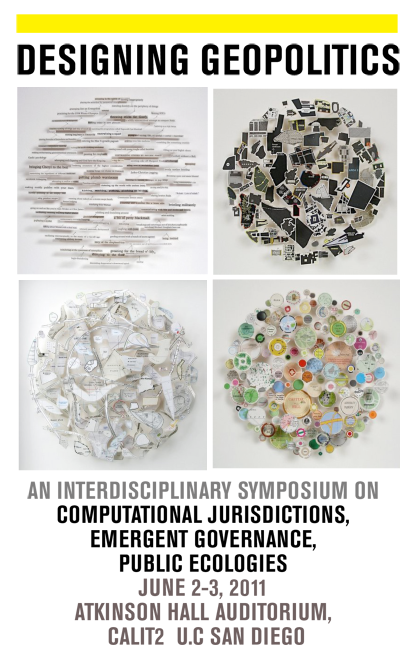June 2-3, 2011 · Atkinson Hall Auditorium, Calit2, UC-San Diego
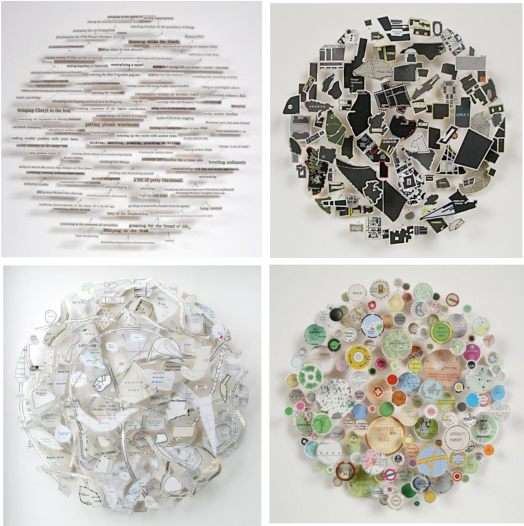
DESIGNING GEOPOLITICS
An Interdisciplinary Symposium on Computational Jurisdictions, Emergent Governance, Public Ecologies
How does a digital Earth govern itself? Through what jurisdictions, what rights of the citizen-user, what capacities of enforcement, and in the name of what sovereign geographies? In fact we simply do not know. But in the face of fast-evolving cyberinfrastructures that outpace our inherited legal forms on the one hand, and a multigenerational arc of ecological chaos on the other, we need to find out quickly: we need to design that geopolitics.
Geo-graphy, Geo-technolgy, Geo-governance
These questions are not only technology policy and standards issues, nor can they be properly addressed by extrapolating and extruding political models from past Modern eras, nor can they be fully articulated by political philosophical models, nor can they be directly diagrammed and modeled as design engineering equations. Instead variations on each of these faculties must be enrolled all at once.
D:GP’s interest is in presupposing tectonic shifts in both what is possible and what is necessary to re-speculate upon geo-technology and to re-design geo-governance. What are the imagined communities upon which it based? How does planetary-scale computation generate new geographies over which traditional State jurisdictions may have little control? How do these spaces constitute authority on their own formal and informal terms? In that future what is new and what is archaic? What maps, what media of exchange and equivalence, what agency of the object, what politics of risk,? Can we design these questions, or only be designed by them?
Contemporary geopolitics are knotted throughout these problematics: how the use of SMS and Twitter in Iran, Haiti, Philippines, Russia suggests another stratum of crowds and power, how Wikipedia formalizes consensus from a heteroglossia of interests, how Google services do and do not circumvent national authority in China. How is it that some emergent geographies (such as cloud computing) as well as traditional geographies (such as Dar-al Islam) are able to to compete with States not only for claims over legitimate violence, but also claims over legitimate citizenship? What are the long-term ramifications that privatization of the common intellect by search and social network platforms will have on humanity’s ability to self-govern? (We could easily add any number of torn-from-the-headlines developments: Wikileaks and data.gov, net-neutrality and the Golden Shield, Dot-P2P & OpenDNS, the Google Earth stand-off between Costa Rica and Nicaragua, etc., etc.)
The Faculties of Design
The issues raised by DESIGNING GEOPOLITICS are central to what is undoubtedly the most consequential challenge to our capacity to redesign geo-governance: the fragility of our climatic and ecological commonwealth. The Copenhagen conference underscores why international, top-down organizations have a limited ability to enforce transformation through legal consensus. The climate crisis may necessitate the formulation of new scales of jurisdiction (both smaller and larger than the member state), new modes of calculating energy (quantifying, computing, distributing, visualizing a polity of electrons), and new forms of networked geopolitics (that can serve the estimated 650 million migrants by 2050.) Or what if new techniques of energy production, exchange and dissemination make these political economies of electron scarcity moot? If so that is an even more challenging problem for our speculative political science.
It is also a problem that cannot be accounted for by simple oppositions of the open vs. the closed, of the free vs. the unfree, the public vs. the private, the state vs. the market, the north vs. the south, the emerging vs. the emergent, the network vs. the institution, the smooth vs. the striated. We identify closely curated commons: digital commons (Wikipedia), ecological commons (rain forests), biological commons (genomes), social commons (educational systems), etc. as the results of complex adaptive systems operating through specific protocols and regulation mechanisms. And while the value they possess is in principle generally and generously sharable, when they are over-exploited by specific initiatives without some mechanism for renumeration to their care, their values as our commonwealths are diminished. The open can destroy the open as much as the closed can.
How can we prototype alternatives? These destabilizations of governance and geography signal critical challenges to our capacities of analysis but more importantly to faculties of design. This conference argues that the architecture of the geopolitical is a meta-design problem that no single perspective can comprehend let alone build, but that it remains forever a highly volatile arrangement of untranslatable situations into which we have no real choice but to enter into directly: territories, institutions, constitutions, conditions of sovereignty, citizenship. While emergent technologies both drive and index these transformations, how they could mediate the emergence of global-scale imagined communities is the critical issue (and it is one through the arts and humanities have a central authority in that the circulation of information structures real human meaning, and how meaning structures the world.)
Conference and Convention
Toward this, we convene Designing Geopolitics: Computational Jurisdictions, Emergent Governance, Public Ecologies, a interdisciplinary conference that will organize scholars from a wide range of disciplines and professions around these critical issues. We have made initial invitations to participants from the Visual Arts, Political Science, Philosophy, Systems Ecology, Engineering, Computer Science, History, Architecture, Literature, Interaction Design, Anthropology, Information Sciences, among others. We have also extended invitations to key strategic thinkers at some of the private companies whose work most directly bears on our issues. The conference program will align the design, the humanities with technologists and scientists and will place Calit2 at a critical interface between these academic and private missions. The event is supported by UCSD through Calit2, the Division of Arts and Humanities, and the Department of Visual Arts.
Schedule
(subject to change)THURSDAY, JUNE 2
| 9:30 | Designing the Century: Futurity's Past Benjamin H. Bratton, Norman Klein, Geoff Manaugh |
| What does it mean to think about design at the scale of the century, to design a century per se? Has the modern obsession with futurity and futurism actually blinded us to the long, slow duration of events and contexts over which we do actually have some control? What is the status of the century as a mesologic scale of systems design and of historical representation? What does the construction of the future in our recent past tell us about our capacities and incapacities to articulate our predicament? This panel examines the past, present and future of “the future” as a format, alibi and site condition for design. |
|
| 11:00 | Network Polis: Promise/Peril James Fowler, McKenzie Wark, Metahaven (video from Netherlands) |
| The 00‘s will be marked as moment with the conceptual hegemony of network topologies to describe and mobilize our understanding of complex systems, from information globalization to immunology, and from response marketing to popular uprisings. If the network topology of Modern institutional history was one of nodes producing and dominating edges, is our multipolar (some would say non-polar) global territory one for which edges in turn produce and dominate nodes? What is the promise and what is the peril of synthesizing the critical topological imaginary into a pursuit of the network diagram? |
|
| Third Spaces: Disruptive Design with the next 300 Million Chinese Internet Users Tricia Wang (video from China) | |
| 1:30 | “Force is a Diagram of Forms”: Architecture, Emergence, Emergency Teddy Cruz, Jordan Crandall, Hernan Diaz-Alonso |
| What is the content of the architectural imaginary? What is its embededness, its conditionality? How has the radical dispersion of the partition and the frame into software-based techniques changed the terms by which space is contested? How is an architectural practice that posits building as an index of extrinsic sociological demands able to produce and mediate alternative forms of habitation and exchange? How is the apparent autonomy of architecture‘s pursuit reliant on the affective experience of a culturally conditioned aesthetics? Together, what is architecture‘s assignment — if any at all— to instantiate new forms of durable, enforceable structure? |
|
| 3:00 | Data as World, World-Image, World-Making Lev Manovich, Kelly Gates, Molly Wright Steenson |
| The discovery and institutionalization of computation as a form and format of knowledge has brought not only novel techniques but an informational ontology which discloses the world as given to digital inquiry. How does information ontology change the agenda of the Humanities, now less occupied by human phenomenology? But In turn how does the pursuit of a computational semiosis at the surface of experience transform the performance of identity and the non-identical alike? How has the conception of the cybernetic circuit defined how the built environment can be modeled and constructed as an information architecture? |
FRIDAY, JUNE 3
| 9:30 | Planetary Data, Planetary Governance Larry Smarr, Naomi Oreskes, Charlie Kennel |
| Historically, governance has assumed the shape of the information technology it can use to describe and organize the spaces over which it claims sovereignty. Cyberinfrastructure envelopes an entire planet, turning the globe into an instrument of self-quantification. Today those technologies are not only superseding national boundaries, they produce new forms of territory in their image. The challenge of managing a planet now represented as a single domain with a granularity heretofore impossible is one of the key challenges put to cyberinfrastructural design. But the sheer quantity of data does not guarantee governability. This is particularly true for ecological governance. The reality described can be overwhelmed by ideological obfuscation. More importantly, however, the politics of data require the design of forms of production, storage, semantics, distribution, surveillance, structure that exceed those possible through sheer quantification. Particularly, what is the capacity of science to provide models for how a global politics of information can constitute itself? |
|
| 11:00 | Design and Post-Humanism Ed Keller, Vernor Vinge, Rene Daalder |
| To survive Anthropocene we may have to let go of some deeply held understandings of humanity‘s place in the world. Another Copernican revolution, another Rheticus, another de-centering of the human from the center of the stage, may in fact be the basis of the design program we require. Utopias are, after Fredric Jameson, always a rumination on totalities, but designing totalities has proven quite bloody. We‘ve just escaped a century defined by the militarization of utopias (and staunchly defended on precisely these terms by Alain Badiou). How do we hold these two in mind at once? That the assignment is a comprehensive (Copernican) rotation in how we locate our ability to design and designate, and that the imagination of the totality (the utopian) may arrive only as partial and incompatible fragments? | |
| Break | |
| 1:30 | The Agency of Code: Form, Tool, Policy Casey Reas, Ricardo Dominguez, Elizabeth Losh |
| The motto of the open government movement‘s digital vision is “government as a platform,” that is, government not only as an information producing and gathering entity but as a ubiquitous and democratically re-programmable machine for making the world-as-information as generally useful as possible. In this, self-governance becomes (depending on which project is invested) the cybernetician‘s dream of infinite leisure, infinitely rationalized labor and/or one of infinitely autopoetic social systems. But “State as a codebase” has an equally ominous promise for when it works as for when it fails: as both a society of control and as a fragile infrastructure. Further, the globalization of information computing technology produces new modes of citizenship and sovereignty in its image, decoupling Modern logics of state and geography. Here it is “platform as governance,” and the agency of code refers not only to how a social domain formulated through software introduces specific biopolitics, but also to how the literacy of programmability becomes technique to modulate that domain. |
|
| 3:30 | Geophilosophy, Geoaesthetics, Geopolitics Manuel De Landa (audio from Spain), Peter Krapp |
| Geophilosophy challenges the scales at which design can define its work in the world: both spatial orders of magnitude—from the nanometric to the astronomic-- and temporal scales from the microseconds of neuroscience to the millennia of geologic and ecological structure. Any jurisdiction, any site condition, is constituent of multiple enveloping habitats, which makes any local/global distinctions utterly relational. One pole always envelopes and is enveloped by the other. So after Jean-Luc Nancy, the geophilsophical is perhaps directly distinct from really-existing “globalization.” Supercomputing does not inoculate us from feudalism, from superstition, but it can, perhaps, provide for its opposite: a futurism without guarantees, only plasticity. |
Speakers
Benjamin H. Bratton ↪
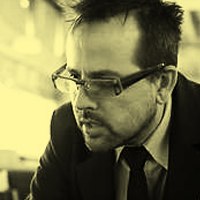
Benjamin H. Bratton is a sociological, media, and design theorist. He is Associate Professor of Visual Arts at the University of California, San Diego, and Director of the Center for Design & Geopolitics at the California Institute of Telecommunications and Information Technology, one of the premier applied research institutes in the application of supercomputing and very-large scale data visualization across the sciences, humanities and social sciences.
Adam Bly ↪

Adam Bly is the founder and CEO of SEED Media Group, an integrated media and technology company committed to helping advance science and its potential to improve the state of the world. Adam began his career at the age of 16 as the youngest researcher at the National Research Council of Canada, where he spent three years studying the biochemistry of cancer. Following his time in the lab, Adam set out to launch Seed, a new type of science magazine for our times—tag-lined “Science is Culture”—with the mission of raising scientific literacy. “The best comparison for Seed,” wrote a media critic, “is the early years of Rolling Stone, when music was less a subject than a lens for viewing culture.” Under Adam’s leadership, Seed received two National Magazine Award nominations, for Best Design and General Excellence, the magazine industry’s highest honor. Seed’s success has since led to the development of new brands, platforms—from software to data visualization—and markets—from Europe to Brazil.
Jordan Crandall ↪
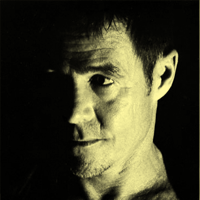
Jordan Crandall is a media artist, theorist, and performer. He is Associate Professor in the Visual Arts Department at University of California, San Diego. His video installations have been presented in numerous exhibitions worldwide; currently, in group exhibitions at the Tate Modern, the San Francisco Museum of Modern Art, and the Walker Art Center. His most recent video installation Hotel (2009) probes into the realms of extreme intimacy, where techniques of control combine with techniques of the self and paranoia combines with pleasure. Crandall is currently developing a new philosophy of the event entitled “Gatherings,” which works across the life sciences, the social sciences, the digital humanities, urban design and architecture. Crandall writes and lectures widely. He is the founding editor of the new journal Version (http://version.org).
Teddy Cruz ↪
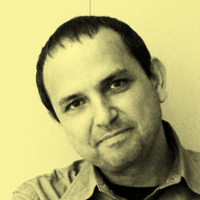
Teddy Cruz was born in Guatemala City. He obtained a Master in Design Studies at Harvard University in 1997 and established his research-based architecture practice in San Diego, California in 2000. He has been recognized internationally for his urban research of the Tijuana-San Diego border. In 1991, he received the prestigious Rome Prize in Architecture and in 2005 he was the first recipient of the James Stirling Memorial Lecture On The City Prize. His work has been profiled in important publications including The New York Times, Domus and Harvard Design Magazine. In 2008, he represented the US in the Venice Architecture Biennial and this year his work will be included in Small Scale, Big Change exhibition at MoMA. He is currently a professor in public culture and urbanism in the Visual Arts Department at University of California, San Diego, where he co-founded CUE / Center for Urban Ecologies.
Rene Daalder ↪

Rene Daalder is a Los Angeles based filmmaker whose work is as diverse as it is prolific. He has written and directed 6 feature films as well as numerous television and music related projects, in Europe, the US and Canada. He has worked with Jan de Bont, Frans Bromet, and Rem Koolhaas as well as a broad range of musicians, from the Sex Pistols to Supertramp, and from Metallica to Beck and Bob Dylan. Often operating at the cutting edge of his medium and heavily involved with special effects, software development and music, Daalder has gained worldwide recognition as a pioneer of Virtual Reality and digital motion picture technologies. His Los Angeles based company American Scenes Inc consults for computer imaging studios all over the world and develops technology-driven TV show formats as well as groundbreaking community driven website projects, i.e. SpaceCollective.org with interaction designer Folkert Gorter, which was publicly launched in 2008.
Manuel De Landa ↪

Manual De Landa is a New York based philosopher and science writer with an exceptionally cross-disciplinary body of work. He has written extensively on nonlinear dynamics, theories of self-organization, artificial life and intelligence, chaos theory as well as architecture, and history of science. Born in Mexico City he moved to New York in 1975 and became an independent filmmaker. In 1980 he turned his attention towards the computer, a pioneer programmer and computer art, before he emerged as one of the leading theorists of the electronic world. De Landa is Adjunct Professor at University of Pennsylvania in Philadelphia and the Gilles Deleuze Chair of Contemporary Philosophy and Science at the European Graduate School EGS but currently lectures extensively in the United States and Europe. His essays are published in numerous journals, and he is the author of War in the Age of Intelligent Machines(1991), A Thousand Years of Nonlinear History (1997), Intensive Science and Virtual Philosophy (2002), and A New Philosophy of Society: Assemblage Theory and Social Complexity (2006).
Hernan Diaz-Alonso ↪

Principal and founder of Xefirotarch, Based in Los Angeles, considered one of the most influential voices of his generation. For the last several years he has been a studio design and visual studies professor and is the Thesis coordinator at SCI-ARC Los Angeles. He is also design studio professor at the GSAPP - Columbia University, New York and Professor at University fur Angewandte Kunst Wien. He received his Architecture degrees from the National University of Rosario, Argentina and from Columbia University’s AAD Program from which he graduated from with honors and received several design awards. In 1996, he worked as a designer in the office of Enric Miralles in Barcelona and in 2000-2001 he was senior designer at Eisenman Architects in New York.
Ricardo Dominguez ↪
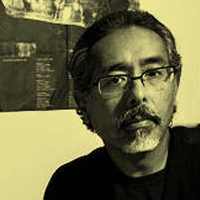
Ricardo Dominguez is a co-founder of The Electronic Disturbance Theater (EDT), a group that developed Virtual-Sit-In technologies in 1998 in solidarity with the Zapatista communities in Chiapas, Mexico. His recent Electronic Disturbance Theater 2.0 projects with Brett Stabaum, Micha Cardenas, Amy Sara Carroll, and Elle Mehrmand is the *Transborder Immigrant Tool* (a GPS or “Geo-Poetic System” cellphone safety net tool for crossing the Mexico/U.S border. It was the winner of “Transnational Communities Award,” funded by *Cultural Contact*, Endowment for Culture Mexico—U.S. and handed out by the U.S. Embassy in Mexico), also funded by CALIT2 and two Transborder Awards from the UCSD Center for the Humanities. The Transborder Immigrant Tool has been exhibited at the California Biennial 20 10 (OCMA), Here Not There (MOCA, La Jolla), and recently in San Salvador, El Salvado. Ricardo is an Associate Professor at UCSD in the Visual Arts Department, a Hellman Fellow, and principal investigator at CALIT2 (http://bang.calit2.net).
James Fowler ↪

James Fowler is a Professor in the School of Medicine and the Division of Social Sciences at the University of California, San Diego. He was recently named a Fellow of the John Simon Guggenheim Foundation and one of Foreign Policy’s Top 100 Global Thinkers. James’s work lies at the intersection of the natural and social sciences. His primary areas of research are social networks, behavioral economics, evolutionary game theory, political participation, cooperation, and genopolitics (the study of the genetic basis of political behavior).
Kelly Gates ↪
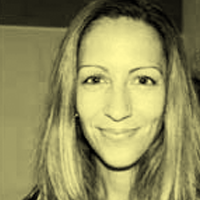
Kelly Gates major research interests are new media, science and technology studies, and cultural policy studies. Gates studies the social dimensions of new media technologies, their institutional and cultural histories, and how various forms and uses of new media both support and challenge existing institutions, cultural practices, and ways of communicating. She is interested in the relationship between the technical and the political: how political priorities are embedded in technical systems, and how an intense concern with technological development shapes present political priorities. Her recent research has investigated the central role of surveillance and identification systems in the development and expansion of information networks. Kelly Gates is a faculty member with UC-San Diego’s communications department.
Elizabeth Losh ↪
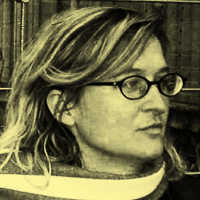
Elizabeth Losh is Director of Academic Programs for the Culture, Art, and Technology Program at UCSD, where she also teaches courses on digital rhetoric and public communication. Her research studies institutions as digital content-creators, the discourses of the “virtual state,” the media literacy of policy makers and authority figures, and the rhetoric surrounding regulatory attempts to limit everyday digital practices. Losh has published articles about videogames for the military and emergency first-responders, government websites and YouTube channels, state-funded distance learning efforts, national digital libraries, political blogging, and congressional hearings on the Internet.
Ed Keller ↪
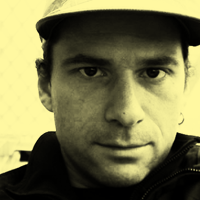
Ed Keller is a designer, professor, writer, musician and multimedia artist. He is also Associate Dean of Distributed Learning and Technology at Parsons The New School for Design, and Associate Professor in the Parsons School of Design Strategies, in NYC. Keller’s professional accomplishments include co-founding with Carla Leitao AUM Studio, an award winning architecture and new media firm that has produced residential projects, competitions, and new media installations in Europe and the US. They have participated in urban design and architecture competitions including MAK Vertical Garden; Turku Finland; UIA Celebration of Cities (National Award); House for Andrei Tarkovsky (first prize) and Museum for Nam June Paik. In academia, he has taught graduate design studios and seminars studying the connections between cinema, architecture, locative media, and digital game design.Taught at the Columbia University GSAPP from 1998-2010. In 2000-01, he was acting director of the GSAPPs Advanced Architectural Design MS degree. Has also taught at SCIArc, as founder/coordinator of the MediaSCAPES MDesR program and fulltime faculty 2007-09; FIU Miami (Cejas Eminent Scholars Endowed Chair); and at UPenn, Pratt, RPI, and Bennington. Since 1993 has lectured on architecture, film and digital media at institutions including Harvard, Pratt, Princeton, Univ. Ramon Llull, Columbia Univ. GSAPP, Parsons, UPenn, Rensselaer Polytechnic, Iowa State, Ohio State, and Rice. Chronomorphology: Active Time in Architecture, a survey of his graduate design studios at the Columbia GSAP, was published in 2004 by CBA. His work and writing has appeared in Praxis, ANY, AD, Arquine, Leonardo Electronic Almanac, Architecture, Parpaings, Precis, Wired, Metropolis, Assemblage, Ottagono, and Progressive Architecture.
Charlie Kennel

Charles F. Kennel was born in Cambridge, Massachusetts, was educated in astronomy and astrophysics at Harvard and Princeton. He then joined the UCLA Department of Physics, developed a research career in space plasma physics and astrophysics, and chaired the department for three years. He eventually became the UCLA Executive Vice Chancellor, its chief academic officer. From 1994 to 1996, he was Associate Administrator at NASA and Director of Mission to Planet Earth, the world’s largest Earth science program. His experiences at NASA convinced him to devote the rest of his career to Earth and environmental science. Kennel was the ninth Director of Scripps Institution of Oceanography and Vice Chancellor of Marine Sciences at the University of California, San Diego, from 1998 to 2006. Dr. Kennel now directs the UCSD Environment and Sustainability Initiative, embracing teaching, research, campus operations, and public outreach, and is a distinguished professor of atmospheric sciences at Scripps.
Norman Klein ↪

Norman Klein is a cultural critic, and both an urban and media historian, as well as a novelist. His books include The History of Forgetting: Los Angeles and the Erasure of Memory, Seven Minutes: The Life and Death of the American Animated Cartoon, and the data/cinematic novel, Bleeding Through: Layers of Los Angeles, 1920-86 (DVD-ROM with book). His next book will be The Vatican to Vegas: The History of Special Effects. (Fall, 2003). His essays appear in anthologies, museum catalogs, newspapers, scholarly journals, on the WEB—symptoms of a polymath’s career, from European cultural history to animation and architectural studies, to LA studies, to fiction, media design and documentary film. His work (including museum shows) centers on the relationship between collective memory and power, from special effects to cinema to digital theory, usually set in urban spaces; and often on the thin line between fact and fiction; about erasure, forgetting, scripted spaces, the social imaginary.
Peter Krapp ↪
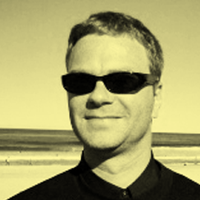
Peter Krapp is Associate Professor of Film & Media Studies, Visual Studies, and English at the University of California Irvine, and affiliated also with the Department of Informatics. He is the author of Deja Vu: Aberrations of Cultural Memory (University of Minnesota Press 2004) and of the forthcoming book Noisy Channels: Glitch and Error in Digital Culture (University of Minnesota Press 2011).
Geoff Manaugh ↪
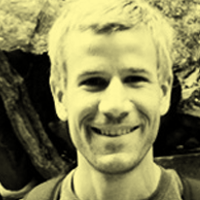
Geoff Manaugh is the author of BLDGBLOG and “The BLDGBLOG Book,” former senior editor of Dwell magazine, and a contributing editor at Wired UK. In addition to lecturing on a broad range of architectural topics at design schools and museums around the world, he has taught design studios at Columbia University, the Pratt Institute, the University of Southern California, and the University of Technology, Sydney. He lives in Los Angeles.
Lev Manovich ↪

Lev Manovich is the author of Software Takes Command (released under CC license, 2008), Soft Cinema: Navigating the Database (The MIT Press, 2005), and The Language of New Media (The MIT Press, 2001) which is described as “the most suggestive and broad ranging media history since Marshall McLuhan.” Manovich is a Professor in Visual Arts Department, University of California -San Diego, a Director of the Software Studies Initiative at California Institute for Telecommunications and Information Technology (CALIT2), and a Professor at European Graduate School (EGS). He is much in demand to lecture around the world, having delivered 450 lectures, seminars and workshops during the last 10 years.
Metahaven ↪
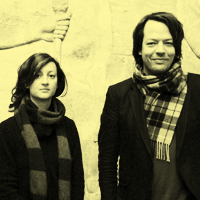
Metahaven is a studio for design and research based in Amsterdam, founded in 2006 by Daniel van der Velden and Vinca Kruk. Much of Metahaven‘s early visual work and writing is combined in the book Uncorporate Identity (Lars Müller Publishers, 2010), featuring contributions from Boris Groys, China Miéville, Keller Easterling, David Grewal, and others. Metahaven‘s solo exhibitions include Affiche Frontiére (CAPC musée d‘art contemporain de Bordeaux, 2008) and Stadtstaat (Künstlerhaus Stuttgart and Casco Utrecht, 2009). They have exhibited at Forms of Inquiry (Architectural Association, London, 2007, cat.), On Purpose—Design Concepts (Arnolfini, Bristol, 2008), Manifesta8—The European Biennial for Contemporary Art (Murcia, Spain, 2010, cat.), and Graphic Design Worlds (Triennale Design Museum, Milan, 2011, cat.). Daniel van der Velden is a senior critic in graphic design at Yale University, New Haven, and he teaches at the Sandberg Institute in Amsterdam. Vinca Kruk is a tutor of editorial design at ArtEZ Academy in Arnhem, and she teaches design at Otis College of Art and Design, Los Angeles.
Naomi Oreskes ↪
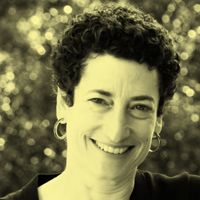
Naomi Oreskes (Ph.D., Stanford, 1990) is Professor of History and Science Studies and Adjunct Professor of Geosciences at the University of California, San Diego. Her research focuses on the historical development of scientific knowledge, methods, and practices in the earth and environmental sciences, and on understanding scientific consensus and dissent. She is the author of The Rejection of Continental Drift (Oxford University Press, 1999); Merchants of Doubt: How a Handful of Scientists Obscured the Truth on Issues from Tobacco Smoke to Global Warming(Bloomsbury Press, 2010 (with Erik Conway); and Science on a Mission: American Oceanography in the Cold War and Beyond (to be published by the University of Chicago Press), and is the co-editor of Plate Tectonics: An Insider’s History of the Modern Theory of the Earth (Westview Press, 2001) which was cited by Library Journal as one of the best science and technology books of 2002, and by Choice as an outstanding academic title of 2003. Oreskes’s most recent work deals with the science of climate change. Her 2004 essay “The Scientific Consensus on Climate Change” (Science 306: 1686), led to Op-Ed pieces in the Washington Post, the San Francisco Chronicle, and the Los Angeles Times. Her work has been widely cited in the mass media in the United States and Europe, including the Royal Society’s publication, “A guide to facts and fictions about climate change,” and in the Academy-award winning film, “An Inconvenient Truth.”
Casey Reas ↪
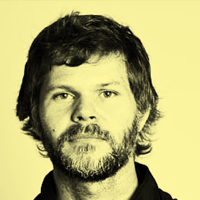
Reas’ software, prints, and installations have has been featured in numerous solo and group exhibitions at museums and galleries in the United States, Europe, and Asia. His ongoing Process series explores the relationship between naturally evolved systems and those that are synthetic. The imagery evokes transformation, and visualizes systems in motion and at rest. Equally embracing the qualitative human perception and the quantitative rules that define digital culture, organic form emerges from precise mechanical structures. He holds a masters degree from the Massachusetts Institute of Technology in Media Arts and Sciences as well as a bachelors degree from the School of Design, Architecture, Art, and Planning at the University of Cincinnati. With Ben Fry, Reas initiated Processing in 2001. Processing is an open source programming language and environment for creating images, animation, and interaction.
Larry Smarr ↪

Larry Smarr is the founding Director of the California Institute for Telecommunications and Information Technology (Calit2), a UC San Diego/UC Irvine partnership, and holds the Harry E. Gruber professorship in Computer Science and Engineering (CSE) at UCSD’s Jacobs School. At Calit2, Smarr has continued to drive major developments in information infrastructure— including the Internet, Web, scientific visualization, virtual reality, and global telepresence—begun during his previous 15 years as founding Director of the National Center for Supercomputing Applications (NCSA). Smarr served as principal investigator on NSF’s OptIPuter project and currently is principal investigator of the Moore Foundation’s CAMERA project and co-principal investigator on NSF’s GreenLight project. In October 2008 he was the Leadership Dialog Scholar in Australia.
Vernor Vinge ↪
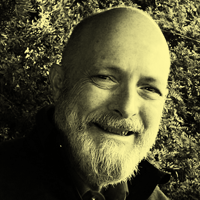
Vernor Vinge is a retired San Diego State University Professor of Mathematics, computer scientist, and science fiction author. In 1982, at a panel for AAAI-82, Vernor Vinge proposed that in the near future technology would accelerate the evolution of intelligence itself, leading to a kind of “singularity” beyond which merely human extrapolation is essentially impossible. In the 1980s and 1990s, he elaborated on this theme, both in his science fiction and nonfiction. He is best known for his Hugo Award-winning novels and novellas “A Fire Upon the Deep” (1992), “A Deepness in the Sky” (1999), “Fast Times at Fairmont High” (2002), “The Cookie Monster” (2004) and “Rainbow’s End” (2006), as well as for his 1993 essay “The Coming Technological Singularity”, in which he argues that exponential growth in technology will reach a point beyond which we cannot even speculate about the consequences.
Tricia Wang ↪

Tricia Wang is a sociologist, technology researcher, and ethnographer who observes internet culture and digital life, specifically the communicative technology practices of under-served populations and focuses on how migrants and youth use communication tools, such as cellphones, internet cafes, or traditional landlines, to manage their social networks. Her work expands research on new technologies by situating everyday communication practices among the socio-political intersection of digital architectures, urban policies, technology protocols, cultural landscapes and spatial orientations. Wang’s goal is to engage with technology policy makers, designers, and leaders in her research sites of China, Mexico. and the U.S. so that they are better informed about the everyday lives of low-income users. She has worked to develop digital literacy programs for the institutions like of the United Nations, National Aeronautics Space Agency, and the NYC public school system. Wang holds a B.A. in Communications from the University of California -San Diego (UCSD), an M.A. in Sociology from UCSD and is currently finishing her Ph.D. in Sociology at UCSD.
McKenzie Wark ↪
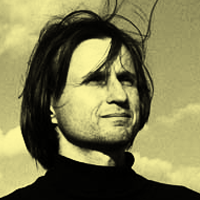
McKenzie Wark is a theorist of media and new media with interests in new media technology, intellectual property, computer games, and new media art and culture. He is the author of A Hacker Manifesto (2004), Gamer Theory (2007), and other things. He is the chair of Culture & Media Studies and Associate Dean at Eugene Lang College at the New School in New York.
Molly Wright Steenson ↪

Molly Wright Steenson is a Ph.D. candidate at Princeton University in the School of Architecture. Steenson is writing a dissertation about intelligence, interactivity, information and computing in architecture, with a specific focus on Nicholas Negroponte and Cedric Price. She’s also a design researcher and strategist who studies how technology and infrastructure fit into our lives. Steenson is also was a professor at the Interaction Design Institute Ivrea in Italy.
Moderators
Sheldon Brown ↪
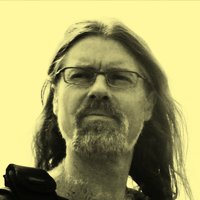
Sheldon Brown combines computer science research with vanguard cultural production. He is Director of the Center for Research in Computing and the Arts (CRCA) at the University of California, San Diego (UCSD) where he is Professor of Visual Arts and a co-founder of the California Institute of Telecommunications and Information Technologies (Calit2). He is also the UCSD Site Director of the NSF supported Industry-University Collaborative Research Center for Hybrid Multicore Computing Research. He has shown his work at: The Museum of Contemporary Art in Shanghai, The Exploratorium in San Francisco, Ars Electronica in Linz Austria, The Kitchen in NYC, Zacheta Gallery in Warsaw, Centro Nacional in Mexico City, Oi Futuro in Rio de Janeiro, Museum of Contemporary Art San Diego, and others. THe has also been featured at leading edge techno-culture conferences such as Supercomputing, SIGGRAPH, TedX GDC and other conferences of leading edge techno-culture. He has been commissioned for public artworks in Seattle, San Francisco, San Diego and Mexico City, and has received grants from the NSF, AT&T New Experiments in Art and Technology, the NEA, IBM, Intel, Sun Microsystems, SEGA SAMMY, Sony, Vicon and others.
Jeremy Douglass ↪

Jeremy Douglass is a postdoctoral researcher in Software Studies at the University of California San Diego, in affiliation with the Center for Research in Computing and the Arts, Calit2, and Visual Arts, with support from the NEH and NSF. His research focuses on approaches to software and code using the methodologies of the humanities and social sciences, as well as approaches to cultural studies using the techniques of software engineering and data mining. One current emphasis is on the art and science of information visualization and its applications to visual culture, including graphic novels, film, and video games. Douglass is active in the digital humanities, software studies, and critical code studies research communities, and is a founding member of Playpower, a MacArthur/HASTAC funded digital media and learning initiative to use ultra-affordable 8-bit game systems as a global education platform. His dissertation “Command Lines: Aesthetics and Technique in Interactive Fiction and New Media” is freely available online.
Joshua Kauffman ↪
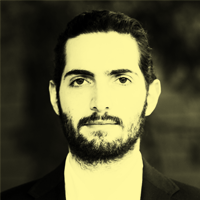
Joshua Kauffman is a designer and entrepreneur who advises on strategic issues in technology, society and geopolitics. Kauffman applies original analysis of global spaces, culture and commerce to the initiation and development of projects for profitable innovation and meaningful cultural intervention. Recent projects include the design of communication infrastructure in Cuba, the conception of an ecologically-optimal product-service system, and the training of civil society groups in Egypt. Some clients include McKinsey, Philips and Freedom House. He has broad international experience in the field of development and is now strategic director at ‘Groupshot,’ a World Bank innovation prize winner which designs technology for informality. In that capacity he‘s leading several projects in Kenya that will focus on the empowerment of informal systems, one of which is in partnership with the Center for Sustainable Urban Development at Columbia‘s Earth Institute. Some of his other activities include consulting on emerging opportunities in personal data, and advising the Arctic Perspective Initiative, which builds and disseminates open systems for enhancing the autonomy and sovereignty of Arctic Peoples.
Joshua M. Taron ↪
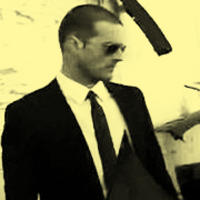
Joshua M. Taron is Principal of Synthetiques, a research + design studio focusing on hybrid ecologies afforded through the interface of virtual and physical economies across multiple scales. He is an Assistant Professor of Architecture at the University of Calgary‘s Faculty of Environmental Design where he co-directs the Laboratory for Integrative Design (The LID), an interdisciplinary research group that brings together researchers from multiple disciplines. Researchers at the LID operate in areas of overlap that exist between design, its allied disciplines of engineering and production, and other fields, such as computer science, material science, mathematics and biology. His current research explores emergent behaviors produced through the integration of agent-based models with structural analysis software. He received Architecture degrees from the University of California, Berkeley and the Southern California Institute of Architecture.
Organizers
Daniel Rehn ↪

Daniel Rehn is a designer and researcher. He is a founding partner with the Center for Design and Geopolitics. He co-directs the LA Game Space—a non-profit community space for game development, research, and culture—as well as the MacArthur-recognized Playpower foundation. His research practice (✖ me+Sarah) constructs experiential narritives that rewrite history and rewire media artifacts. At the Center for Research in Computing and the Arts, Rehn pioneered the analysis and visualization of cultural data with Jeremy Douglass and Lev Manovich. He frequently advises organizations on design, strategy, and concept development.
Tara Zepel ↪

Tara Zepel is a researcher, theorist and intermittent artist. She is currently pursuing a PhD in the Art History, Theory & Criticism at UCSD. Her work explores the intersection(s) between aesthetics and technology, particularly with respect to interaction design and Augmented Reality. Her goal is to reflective engage with current technological practices in a way that pushes conceptions of how our relationship with technology is, might be and should be. Prior to UCSD, Tara earned a B.A. in Literature from Duke (2002) and worked as a project manager for several artists and arts organization as well as doing production and post-production for film and video.
Location
The event will be held in the Calit2 auditorium which holds 202 people and provides world-class telepresence, audio-video recording and webcasting, multimedia presentation, and archiving capabilities as core facility services. The telepresence capabilities of Calit2 Auditorium are particularly important as we anticipate having at least two conference speakers participate via remote video conferencing link from New York and/or Europe. The digital AV capabilities are critical as the conference will be both webcast live as well as archived for subsequent publication and dissemination.
Outcomes
The conference event will be a unique meeting of scholars and practitioners, from disciplinary and institutional positions who normally are not able to collaborate directly even on shared concerns, and facilitation of this is the primary goal. Events will also be recorded and transcribed immediately after their conclusion and will be made publicly available online for scholarly access, public access and policy planning purposes. Further, conference proceedings will form the basis of an edited volume that would have considerable appeal to academic publishers because of the high caliber of participants, the timeliness of subject matter, and uniqueness of such a broadly interdisciplinary range of participants.
Online and offline
The conference will convene in La Jolla, but will available for viewing live online via the web. The events will also be recorded and transcribed for subsequent publication. As event planning continues we will be investigating how in-place web infrastructure at UCSD could be deployed to extend and enhance the conference event across pedagogical strategies.




